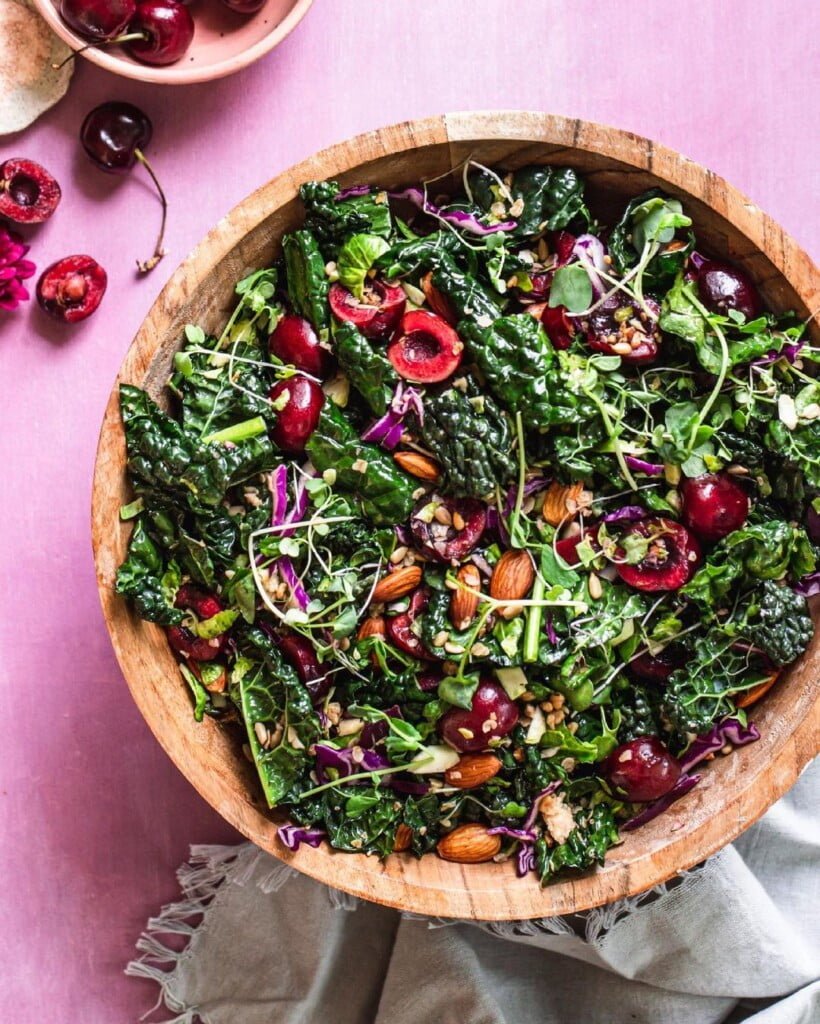The health benefits of cherries and their nutrition facts are enough to justify eating them all season.
A big bowl of cherries is a sure way to say summer without saying it. The tiny, pitted fruits (say that five times fast) are packed with healthy nutrients (antioxidants, fiber, vitamin C) and have a refreshing flavor.
Need more reasons to eat cherries all year? No issue. Read on to learn about cherries’ nutritional value and creative uses in recipes.
A Brief History Of Cherries
The cherry (which grows on trees, hence the stem) is related to other summer staples like plums, peaches, and nectarines, which are all stone fruits. Most cherry varieties are bright red to almost purple, but some (like those grown in Washington) are yellowish. According to James Michael, vice president of marketing — North America for Northwest Cherry Growers and the Washington State Fruit Commission, there are two main types of cherries in the U.S.: sweet (deep red-purple) and sour (bright red).

Cherry Nutrients
Whether you prefer sour or sweet cherries, don’t overlook their nutritional value. The stone fruit is low in calories and high in nutrients like fiber, vitamin C, and potassium, says Kristin Gillespie, M.S., R.D., C.N.S.C. While both types of cherries are loaded with disease-fighting antioxidants, their nutritional profiles differ slightly.

According to the USDA, one cup of sweet raw cherries without pits (154 grams) contains the following nutrients:
- 3 grams fiber
- 97 calories
- 0.3 grams fat
- 1.6 grams protein
- 20 grams sugar
- 25 grams carbohydrates
Sour cherries, on the other hand, have less sugar, fiber, and carbs than sweet cherries. Here is the USDA’s nutritional breakdown of one cup of sour raw cherries without pits:
- 0.5 grams fat
- 77.5 calories
- 2.5 grams fiber
- 13 grams sugar
- 19 grams carbohydrates
- 1.6 grams protein
Cherries’ Health Benefits
Lower Glucose
Despite their high carb content, cherries have a low glycemic index, which means they won’t cause major blood sugar or insulin spikes, says registered dietitian Heather Hall of Nevada. With nearly half of the world’s population now insulin resistant (your body “begin[s] to ignore insulin”), this is a big deal. This causes your pancreas to produce more insulin, which raises your insulin or blood sugar levels. And, ICYDK, higher blood sugar levels increase diabetes risk. Now, replacing high-glycemic foods (like sugar and flour) with low-glycemic foods (like cherries) can help lower blood sugar and protect against diabetes, says Hall.
Occurrence of In
Cherries are high in polyphenols and vitamin C, both of which are antioxidants and anti-inflammatory agents, as well as anthocyanins. (Research shows this is especially true for sour cherries.) However, anthocyanins are water-soluble pigments that give cherries their red color and act as antioxidants by removing free radicals. Why does it matter? Anthocyanins in cherries help fight free radicals (aka unstable molecules) that can cause cell damage and eventually chronic inflammation.

Reduce Muscle Pain
Ever wonder why people drink tart cherry juice before sweating? Because studies show it can help relieve muscle soreness after a strenuous workout. The anthocyanins in cherries can help remove free radicals, reducing oxidative damage from exercise that causes muscle soreness, says Anderson. Workout Recovery Plan.
Ease Arthritis Pain
Cherries can help arthritis and gout sufferers because they are anti-inflammatory, says Gillepsie. (Gout is a type of arthritis characterized by sudden, severe joint pain caused by a build-up of uric acid in the body, per the CDC.) One study found that nondiabetic patients drinking two 8-ounce tart cherry juice bottles daily for six weeks experienced mild to moderate osteoarthritis relief. In another 2012 study, patients who ate cherries for two days had a 35% lower risk of gout attacks than those who did not eat the fruit.
Boost Cancer-Fighting Powers
A 2018 review found that eating cherries improves the body’s ability to fight cancerous cells, especially colon, prostate, breast, and ovarian cancer. According to Carrie Lam, M.D., board-certified family, anti-aging, and regenerative medicine physician in California, the latter: Anthocyanins and vitamin C in cherries are antioxidants that fight or neutralize free radicals, protecting the body from oxidative stress. High levels of oxidative stress can damage cells and DNA, contributing to conditions like cancer. Also, fiber has been linked to a reduced risk of colorectal and breast cancers, according to the American Institute for Cancer Research, which, like Dr. Lam, recommends adding cherries to your diet if you have a family history of these cancers.
Boost Sleep
A natural source of melatonin, cherries are one of the few foods that contain it, according to Hall. Sweet and sour cherries, as well as cherry products, contain melatonin. For example, sour cherry juice (which contains the most melatonin, according to Hall) has been shown to reduce insomnia and promote deeper sleep. Because of its high sugar content, Hall advises against chugging a glass before bed. (And, let’s face it, the possibility of waking up peeing.) According to Hall, most studies on sleep have used cherry products, so the amount of fresh cherries needed to feel the effects of melatonin is unknown.
Cherry Hazards
Caution when eating fresh raw cherries: Prevent choking hazards (especially for young children) and toothaches by avoiding the pits. That’s not the only reason for removing the pit before eating a juicy orb. Cherry pits naturally contain a toxin called amygdalin, which when crushed and eaten becomes cyanide in the body.
Ingest a small pit? Anderson says it’s not as bad as you think. “Don’t worry, accidentally eating a small pit won’t hurt you,” she says. To be extra safe, buy an OXO Good Grips Cherry and Olive Pitter (Buy It, $13, bedbathandbeyond.com).
How to Eat and Pick Cherries
Cherries are available fresh, frozen, canned or jarred, and as juice. During the summer, fresh cherries are available at grocery stores and farmer’s markets (typically June-August, according to Michael). During the rest of the year, they’ll be in the freezer or processed.
Michael suggests buying fresh cherries that are firm, shiny, smooth, and have green, flexible stems. Except for yellow Rainier cherries (from Washington), the darker the color, the sweeter the flavor. The USDA recommends washing your cherries in cold water to remove any dirt from picking them. Not ready to eat? Save cleaning for snack time. Instead, store them uncovered and unwashed in the refrigerator for three to five days, according to Utah State University Cooperative Extension.

While canned cherries, including pie filling, are still cherries, they are often loaded with sugar. When fresh cherries aren’t available, opt for frozen sweet or sour cherries with no added sugar or canned cherries in water (Buy It, $4, walmart.com). Hall emphasizes that when a food is processed, such as heated to make pie filling, it loses nutrients and antioxidants.
Now that you know when and where to buy cherries, it’s time to incorporate them into your diet.
Fruity Recipes to take advantage of Cherries’ Health Benefits
In oatmeal. Adding chopped cherries to oatmeal makes it even more filling (thanks to the fruit’s fiber). Some Maryland-based registered dietitian nutritionist Sarah Schlichter recommends slicing them up and serving them atop toast for an easy morning snack.
Salad topper Cherries go well with any salad, including one made with shaved Brussel sprouts and sesame seeds. Or toss the fruit (de-pit first!) into a quinoa bowl with smoked almonds.
Into jam. Schlichter suggests making cherry jam and spreading it on sandwiches or using it as a marinade for meat.
Smoothies The antioxidant and anti-inflammatory properties of the cherries, along with the protein in the yogurt, make for a great post-workout snack, says Anderson. Try this dairy-free almond cherry recovery smoothie with frozen cherries, banana, almond butter, chia seeds, and almond milk.
kabobs Pork tenderloin kabobs with chipotle peppers in adobo sauce are a delicious summer recipe.
To trail mix. Anderson suggests mixing dried cherries into a homemade trail mix of nuts and seeds.
With chocolate. Schlichter says cherries and dark chocolate are a perfect pair. A bowl of pitted chopped cherries and dark chocolate chips topped with fresh whipped cream is a delicious treat.

